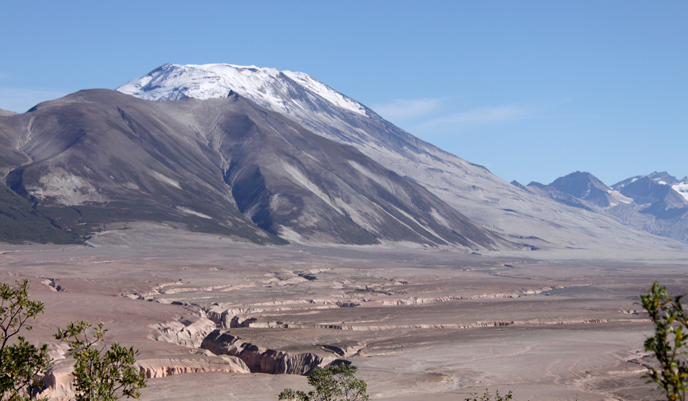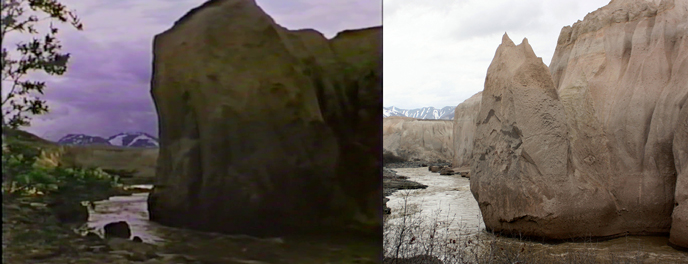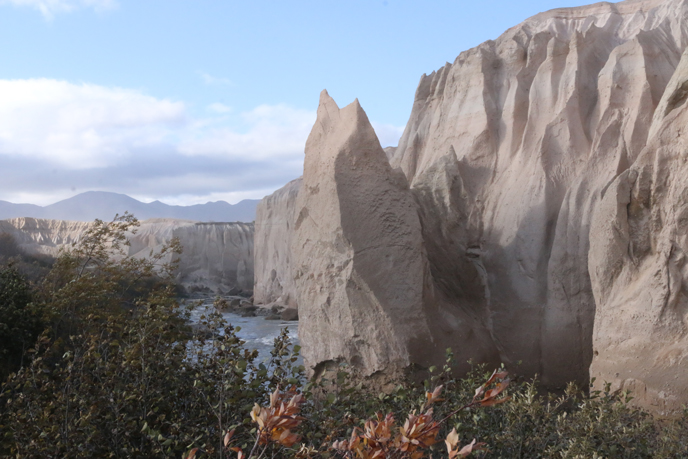Visitors who travel to the Valley of Ten Thousand Smokes can find many amazing sights, but they can't find any smokes. A century ago giant, densely-packed fumaroles fascinated National Geographic expedition members; now they exist only in photos and film reels. As the volcanic material cooled, it was no longer hot enough to boil water, and the fumaroles went extinct.

The present breathtaking but smokeless view from the Robert F. Griggs Visitor Center is a reminder one of earth's newest landscapes is rapidly transforming. NPS photo.
Along the Ukak Falls Trail are many accessible signs of change. Vegetation has crept onto the sheltered areas of the Valley floor. In some places alders and willows have reclaimed territory. Biological soil crusts and small plants—such as horsetail, crowberry, and labrador tea—have also taken root in the pyroclasts which buried the plant life of 1912.
Perhaps the most dramatic transformation is taking place with the pyroclastic deposits themselves. Like all geological features, the Valley of Ten Thousand Smokes is subject to erosion by wind and water. In many places, this geological feature is very soft and sand-like. The same forces which carved the Grand Canyon and the sculpted the hoodoos of Bryce Canyon are at work here as well, only at much faster pace. The ash is so light and loose that strong winds frequently pick up huge clouds of it, sometimes blowing it over Shelikof Strait.
While the winds create impressive sights, water does much more work reshaping the Valley. Immediately after the eruption the new valley floor was one solid mass, unmarked by stream or river channels. By the 1920s, water had begun to cut the deep river gorges we can see today. Rain and snowmelt continue to eat away at unstable cliff walls, washing the loose material into these rivers and creeks which then transport the pyroclast downstream and eventually into Naknek Lake.
The forces of erosion sculpt dramatic, but relatively short-lived features. In recent decades, a large spire greets hikers who reach Ukak Falls. A quick comparison of the photos below shows this was not always true and likely will not be true much longer. The left image is a screenshot from the park's 1979 film Forge of Vulcan. It shows a pyroclastic wall section just downstream of Ukak Falls. The second photo shows the same area in 2011. After thirty-two years of erosion, a large spire now stands.

A quick comparison between two photos shows rapid erosion on a sprire at Ukak Falls. At left is a screen capture from a park film recorded in the late 1970's. At right is the spire in recent years. NPS photos.
During August 2013, this spire experienced a significant erosion event after heavy rains. Daily actions of wind and water have continued to wear away the cliff face, and the photo below shows the spire in October 2014. Note the large dark blocks at the cliff bottom just behind the spire. These are blocks of material that have broken loose from that wall and slumped into the river.

The spire at Ukak Falls still stands in 2015, but its days are numbered. The open spaces to the left of all three photos were once covered in the same thick pyroclastic layers. Today they are gone. NPS/A. Camire.
What will be the fate of the Valley of Ten Thousand Smokes? Will another volcanic eruption bury it beneath new layers of ash and lava? Will green woodlands reconquer? Will wind and water slowly erase the great eruption from the landscape? Or will all these agents work to make something new entirely? Only one thing is certain—on your next trip to the Valley of Ten Thousand Smokes, something will be different.
